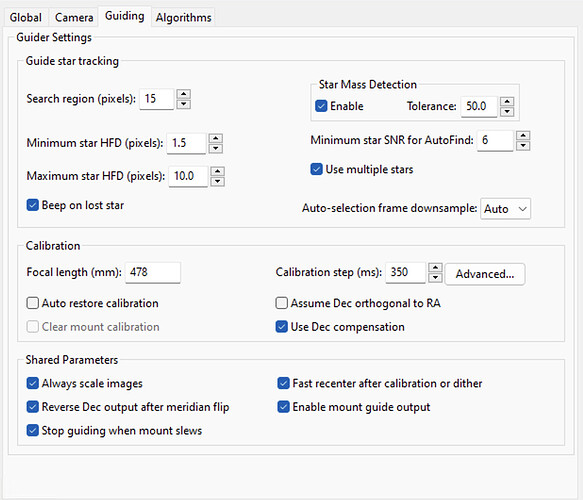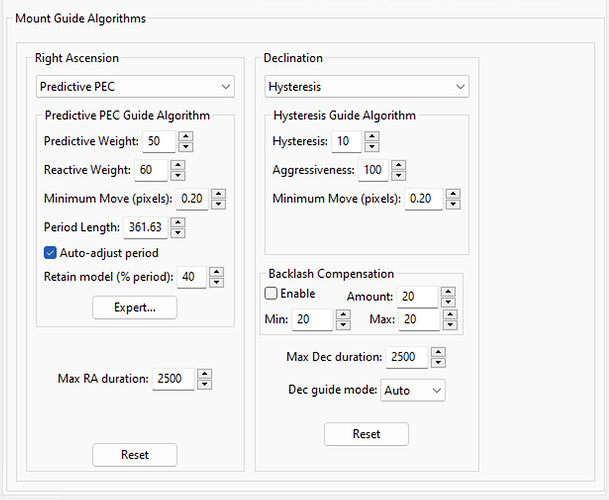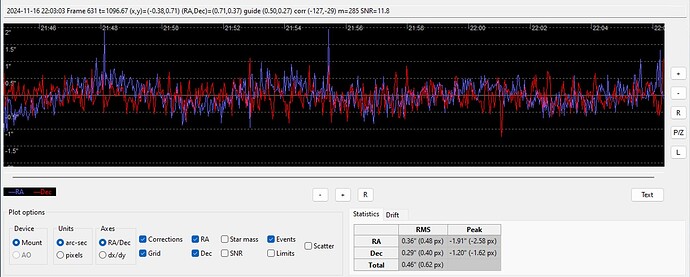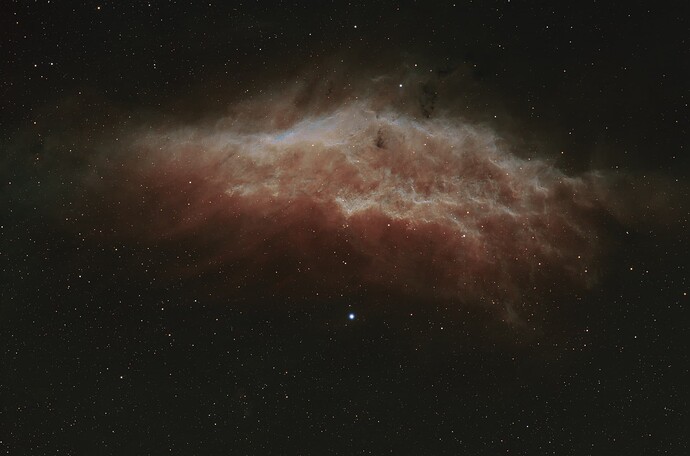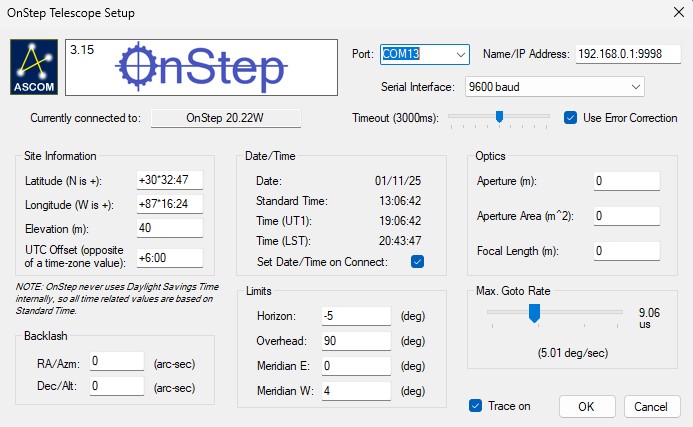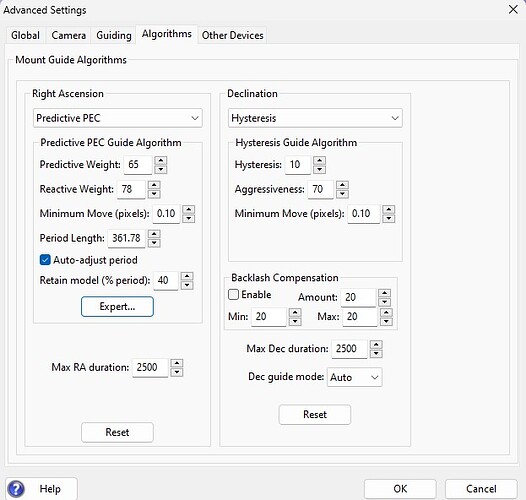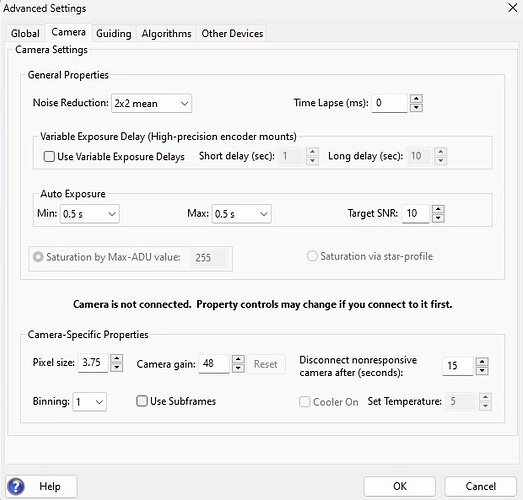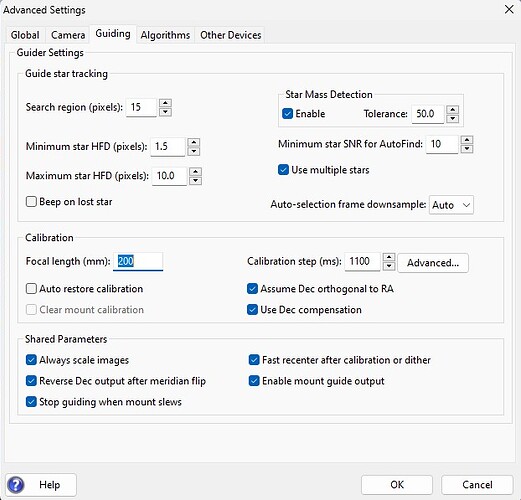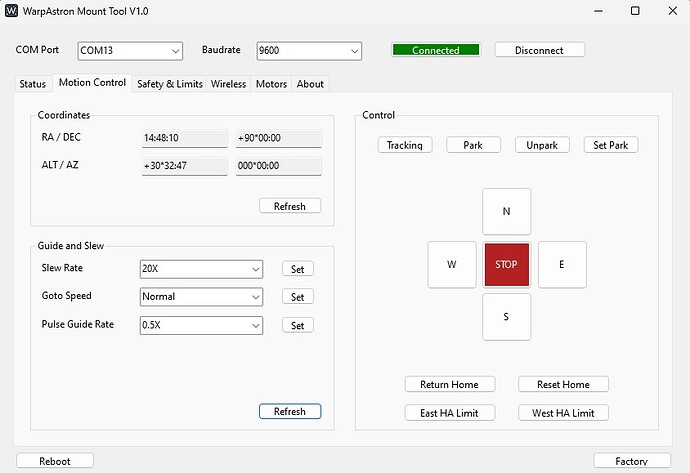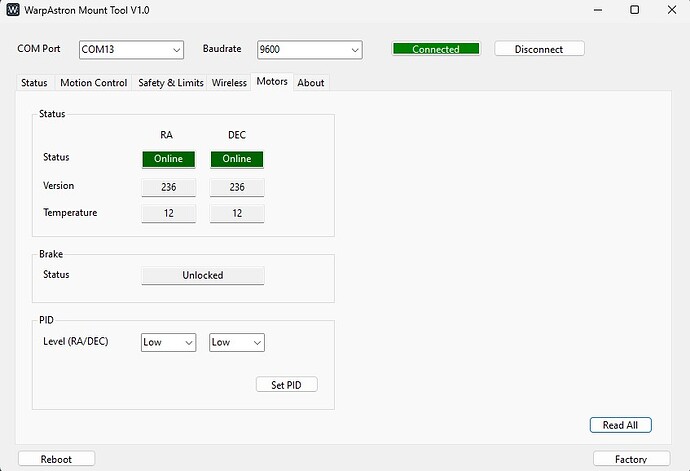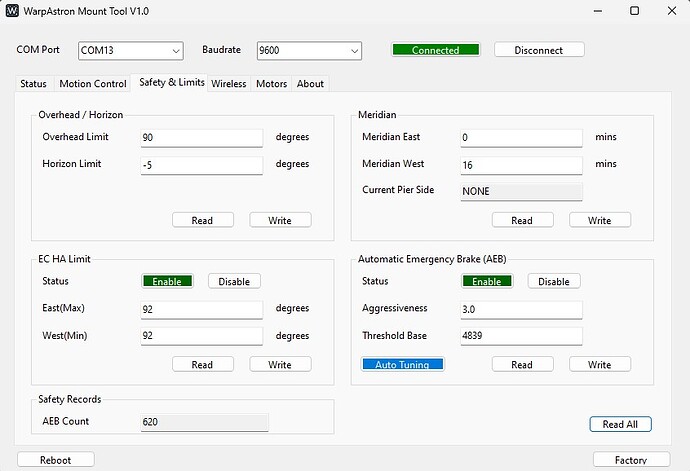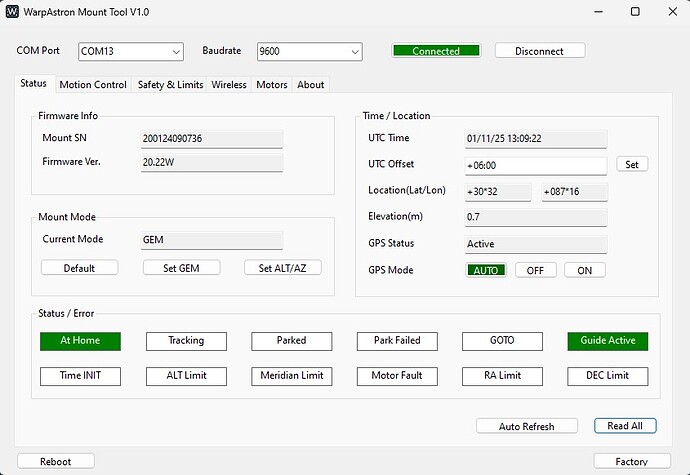I’ve had this mount out two nights and the best I could achieve was >1.5" at any time. The sky conditions were some of the best I’ve had this year. I spent many hours each night dinking with settings to no avail. While watching the guide camera I noticed that in about every other frame, the brightest stars get elongated and I find that the main image also has the same ‘tick’ hanging off each bright star. The rest of the stars are a blurred mess. The PHD2 box around the chosen guide star noticeably bounces around. Guiding should not be this hard to achieve. I’ve got three other mounts (HEQ5, EQ6, AM5) and when I first received them, I had them up and guiding well in a matter of minutes to a couple of hours. This is getting very frustrating. I hope going with the WD-20 wasn’t a huge mistake. Is there anyone out there using NINA/PHD2 and the WD-20 that is getting sub .60" total RMS guiding, as I am sure there is. Would you share your specific settings? It would be much appreciated.
How long are you guide exposures? I found that the typical 2.5 - 3 second exposures i was used to using with my EQ6 were too long. I went with 1 second exposures and i get guiding anywhere from .6 down to .4 or less at times. For some reason these strain wave mounts want shorter exposure times.
Thanks for the reply, Dave. I was going with anything from .5 to 2 seconds. I was thinking AM5 type settings since it’s strain wave, so like my AM5, I started with 1 second. But over the past two nights I have tried everything from .2 to 3 seconds. I did find reference to a 1x setting for the guide rate. I have made that change and will see if it made a difference tonight. I worked on it 6 hours the first night and the same for the 2nd night. About all my patience could stand. ![]() .4" to .6" is what I’m used to on the AM5. I got this mount for the load capacity and the purported ‘no change in PA when locking it down’.
.4" to .6" is what I’m used to on the AM5. I got this mount for the load capacity and the purported ‘no change in PA when locking it down’.
I take it you have run the guiding assistant in PHD2, and apllied the recommended settings as well. If not definitely do that. Hope you get it straightened out. I am really enjoying my experience so far with the WD20.
Try to read this:
Theory on guiding with HD mounts
Maybe this helps to understand where the issues might be and in what direction to tweak the guiding parameters.
I use a 10“ f4.5 system 21kg and my rms are <0.4“…
CS Markus
DaveViews - I have been there too. I have an RST-135E and thought this mount was going to be the same as the other strain wave.
This is my setup and I feel I am successful.
1/ 3 pole star alignment.
2/ Slew to meridian on PHD2 and do calibrations there.
But here is my PHD2 settings: (Reverse DEC is important)
Thanks GS! That’s what I’m looking for… settings. Theory is nice, but I want settings. I’m real close to sending this mount back for whatever monetary loss and order an AM5n. I’ll give it another try tonight, but I am just about fed up with this. It should not be this hard.
Thanks, Markus! That article describes the results that I’m seeing pretty well.
Those settings have helped considerably. The PPEC has really made an improvement over the RA. Is there some precursor requirement to running PPEC, like something needed other than the settings in PHD2?
You can play with those settings a little more to refine it better. I was where you were at until I figured it out. Now I really love using it. Especially for my heavier loads.
Now my only gripe is the hand controller isn’t very refined but I never use it anyway.
Is there a prerequisite to using PPEC in the WD-20? If you’re familiar with EQ6 and if I remember correctly, you record a run of 5 or more worm cycles and then load the file into the mount, then turn on PPEC.
EDIT: I originally set up PPEC to your exact settings and like you, checked the tick for ‘Auto-adjust period’. In looking at it this morning, I find that the ‘Period Length’ of 361.63 had changed to 373.19 giving the impression something is working. That and the fact guiding improved considerably, but not to expectations. I no longer have a second or third star attached to the brightest stars, or what looked like an arm hanging off the stars, and the smaller stars are much more defined. Actually useable images. I changed the setting of sidereal 1x back to .5x this morning and will see if that improves it any. Also, I had an AM5 parked next to it and shooting in the same area of sky as the WD-20. The WD-20 averaged .35" higher error than the AM5. So still a work in progress. At around 2.5 hours into imaging the WD-20 went berserk in guiding and I shut it down. Back at it tonight. Thanks!
Hi,
You can export PHD2 guide logs and share to us for further checking and recommendations, if anything can be found from your guide log.
WarpAstron Support Team
I am at .5x … As for the EQ6, I sold mine a few years back but to answer your question, no you don’t need to load anything.
So again guide rate at 0.5x and my exposures are 1.0s
Dave any updates for us?
Thanks for checking GS. I’m putting it all together to submit to support for any recommendations they might have. Screen shots of settings, along with PHD logs. I did an 8 hour run on NGC1499 on Tuesday night and it went without a hitch. The guide numbers dipped as low as .58" and even held it for a while. Things are definitely looking up. However, I do find OnStep to be a bit taxing versus the set it and forget it of my AM5. A lot to wrap my head around. With anti collision settings and having to deal with the nuts and bolts of the software, to walking out one morning and finding the mount sideways and the scope looking at the dirt. The finished product was rather rewarding, though. I captured 96 images that contained very nice stars and have processed it to produce a pretty nice image.
NOTE: A work in progress… so preliminary.
Nice image, and round stars! Please keep this thread going, I would like to know what else needs to be done if you get it better.
Also a better understanding of pier limits would be great. I have everything at 90,0,0; right now in order to avoid crashing. My image train is somewhat straight unless the rotator pushes my OAG out a little.
Will do! I’ve been hit with an emergency chore for a neighbor, but I’ll be back on this shortly. I too have questions regarding limits. Also, when you talk of calibrating at meridian. What are your PHD2 settings to get to meridian in Calibration Assistant? Is that what you use to calibrate? I didn’t want to plug in numbers that I thought will get me to meridian just to have the scope collide. When I did Calibration Assistant, I didn’t change anything in it and just hit calibrate. The scope slewed to a point near the meridian, but was pointed about 30 degrees towards the south. Thought I was going to have to pull the plug on it. Right now, I don’t trust that I know what the heck I’m doing… because I don’t.
I looked at the PHD logs and there is so much changing of parameters by me in an attempt to better the guiding, making the log unusable for analysis. On the next clear night I will make a run at it with as few changes during as possible and put together something for support and also post everything here.
That is a really pretty picture!
JMD
SUPPORT: YOUR INPUT ON THESE SETTINGS IS REQUESTED
So here are the settings running NINA and PHD2 that I finally wound up with, and this is after updating the mount to 20.22W. The AEB Auto Tuning feature was a big help. If the nightly temperature changes drastically from the previous use then I auto tune again at the start of a new night. Also, I no longer find my mount frozen in the HA limit position. Some of the settings such as limits I’ve copied from what I saw support post in other threads. Still not sure on the particulars of some of the settings.
